'Pinocchio' at 80: 5 things you never knew about the Walt Disney classic
Eighty years ago, moviegoers discovered exactly what happens when you wish upon a star when Walt Disney’s second animated feature, Pinocchio, premiered in theaters on Feb. 23, 1940. Flush with cash from the enormous success of Snow White and the Seven Dwarfs, Disney gambled his studio’s future on an adaptation of Italian author Corlo Collodi’s 19th century story of a walking, talking marionette who longs to be a real boy. At the time, the gamble didn’t entirely succeed: While Pinocchio received instant critical acclaim, it didn’t attract the same crowds that turned out in droves to see Snow White.
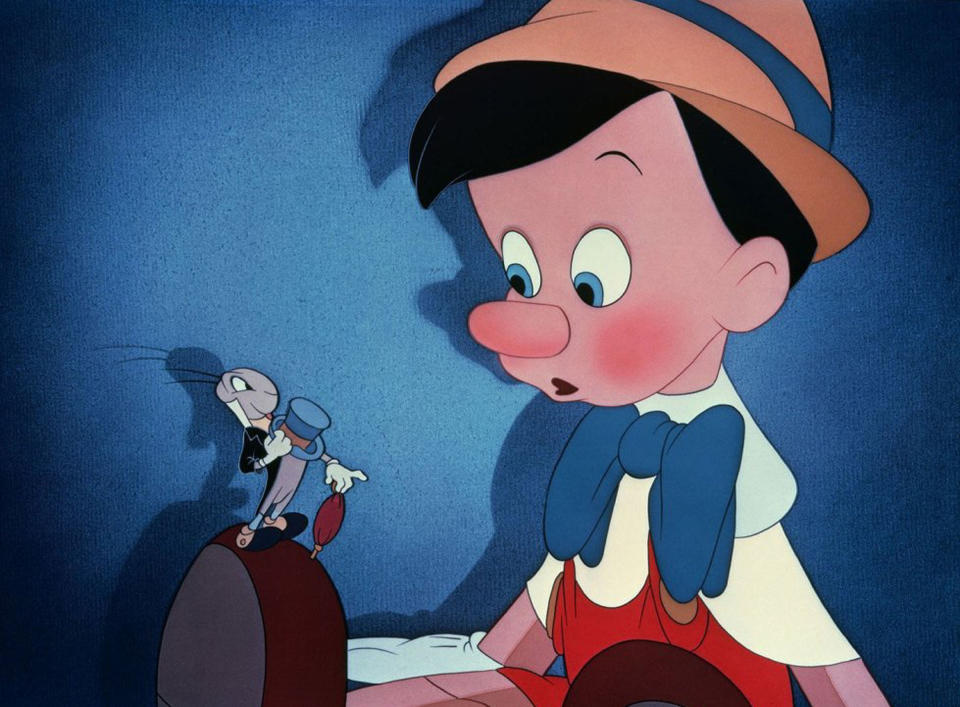
Over the ensuing decades, though, Pinocchio’s reputation continued to grow like the title character’s nose when he tells a lie. Today, the film is widely acknowledged as one of Disney’s crowning artistic achievements, and the source of the song that became the studio’s defining anthem: “When You Wish Upon a Star.” And younger audiences can continue to discover the joys (and horrors) of Pinocchio on its new streaming home, Disney+. Whether you’re seeing Pinocchio for the first (or fifth) time, here are five things you probably never knew about the animated classic.
Disney had to make us love an unlovable character
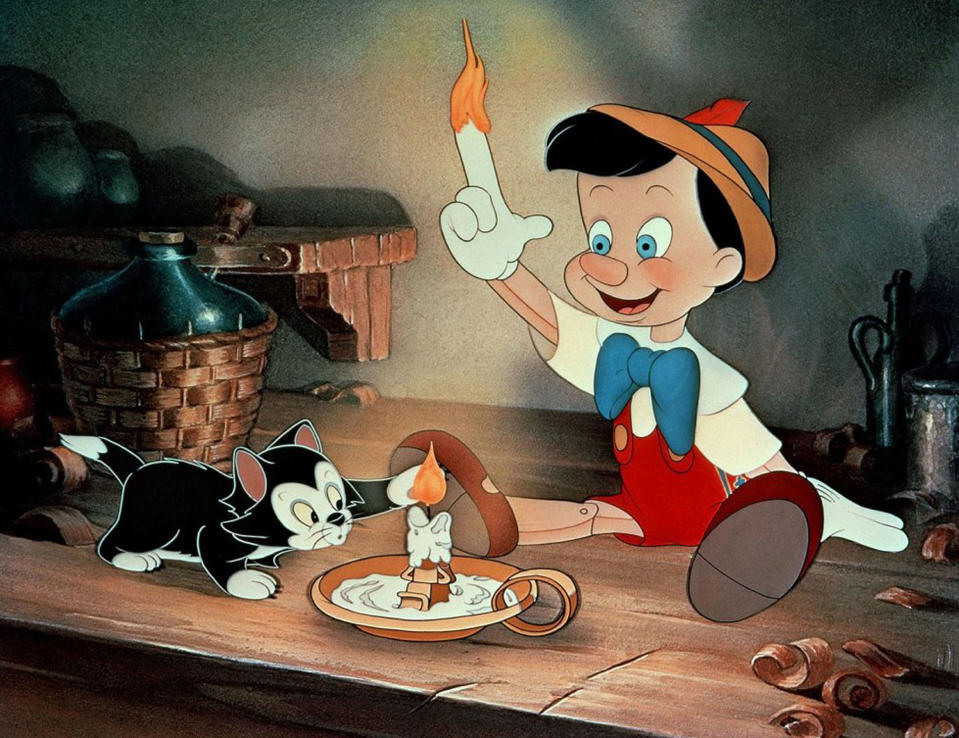
Originally published as a serialized magazine story in 1881, The Adventures of Pinocchio may have been written for children, but Collodi — the pen name of seminary student-turned-author Carlo Lorenzini — didn’t sugarcoat his story for young readers. The text is filled with strange and frightening flights of fancy, including treacherous talking animals, a terrifying amusement park and a host of characters ready to exploit or eat the title character. All of these encounters are intended to drum moral lessons into the story’s target audience.
And Pinocchio himself is far from a G-rated hero: The wooden boy indulges in a variety of bad behavior, and makes a number of poor decisions, on his way to finally being deemed worthy of achieving flesh-and-blood status by the fairy that brings him to life. Archival interviews featured in the 2009 documentary The Making of Pinocchio: No Strings Attached reveal that the earliest versions of the Disney film retained the less-than-sympathetic attitude that Pinocchio displays on the page. “He was brash, he was cocky and he was kind of unlikable,” legendary Disney animator Frank Thomas remarks in the documentary about the first sequences the team completed. Adds his colleague Ward Kimball: “Walt looked at it, and said, ‘It’s not working right.’”
Eventually, animator Milt Kahl found the answer to Pinocchio’s problems by going back to the drawing board… literally. The first drawings of the title character embraced his wooden nature, an approach that Disney found as off-putting as Pinocchio’s personality. So while sketching a test scene with the title character wearing donkey ears and a tail — the result of his transformative stay on Pleasure Island, the stand-in for Collodi’s Toyland — Kahl added some humanity back into the frame. “They were thinking of it in terms of a puppet all the time… and I was very critical of what they had,” Kahl said in a 1984 interview included in No Strings Attached. “I handled it not thinking of so much as a puppet as just a little boy. Walt liked it, so that became the model. It was still refined a little bit more later, but the idea [started there].”
That change in design also fundamentally changed the film’s tone: While Pinocchio’s journey to becoming a real boy was still a perilous one, he endeared himself to the audience instead of pushing them away. His newly youthful appearance convinced Disney to cast child star Dick Jones as the voice of Pinocchio. “They put out a call that they needed a young voice and they tried the adults and they had youngsters and they said Walt Disney wanted a real young boy,” Jones told MovieWeb in 2009. (The actor died in 2014.) “It was just like a radio show, and I had done some radio so I knew what I was in for. Having had all that experience beforehand, I guess I outpaced all the other kids.”
Jiminy Cricket avoided an early death
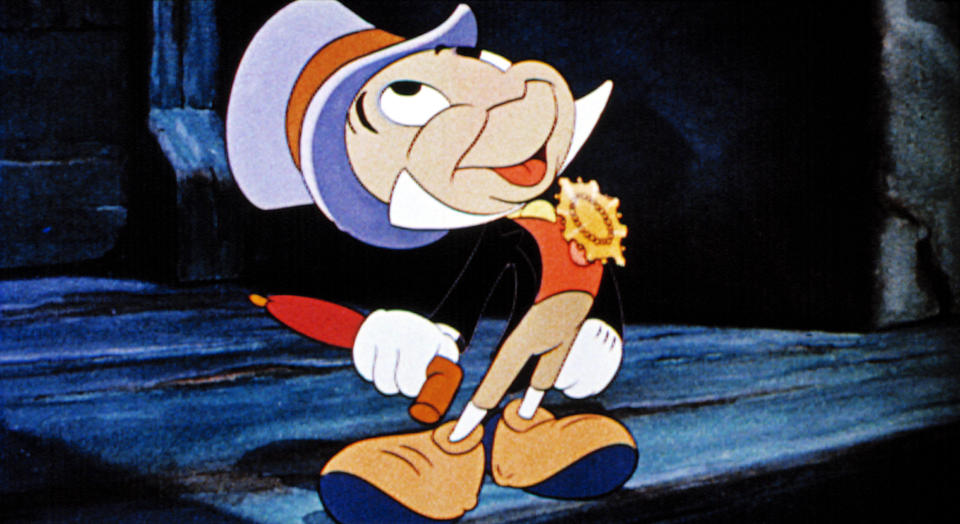
Jiminy Cricket is generally credited as Disney’s first-ever animal sidekick, but if the filmmakers had followed Collodi’s text to the letter, we may never have met such beloved characters as Thumper, Abu or Heihei. In the original story, Pinocchio encounters a talking cricket early on in his adventures and promptly squashes it with a hammer. The insect’s ghost then reappears at various points throughout the narrative, attempting to offer advice that the puppet generally prefers to ignore. Walt Disney decided early on in pre-production that the talking cricket should remain unsquashed. “Walt felt that there was not enough warmth, there’s not enough friendship, there’s no life in the story really,” Thomas says in No Strings Attached. “So that’s where he used Jiminy Cricket.”
Kimball was tasked with turning Collodi’s cricket into a character that Pinocchio, not to mention the audience, would enjoy spending time with. In the illustrations that accompanied the original story, the character was drawn as an oversized insect — not exactly the most cuddly of companions. In the process of turning the talking cricket into Jiminy Cricket, the animator jettisoned almost all trace of the character’s cricket-ness. “My first impression of him was this ugly insect,” Kimball explains in No Strings Attached. “I said, ‘How can that guy carry the picture?’ My answer was, ‘I’ve gotta make him look funny.’ [But] Walt didn’t want a clown cricket. As he put it, ‘Make him cute.’” That’s a lesson that Disney animators have since applied to such critters as skunks, mice and fireflies.
As with Pinocchio, casting proved key to unlocking Jiminy’s charm. In a first for the studio at the time, Disney tapped a celebrity voice for the part: vaudeville and radio star Cliff Edwards. That choice set a precedent that continues to this day, from Eddie Murphy’s Mushu to Shakira’s Gazelle. Before Pinocchio, Edwards was best known for being the first artist to record the song “Singin’ in the Rain.” After Pinocchio, he earned a new signature song that followed him everywhere until his death in 1971: “When You Wish Upon a Star,” the first of many Disney tunes to win an Oscar for Best Original Song.
During Pinocchio, Walt Disney’s Nine Old Men were Nine Young Kids

In their later years, Frank Thomas, Ward Kimball and Milt Kahl were card-carrying members of the Nine Old Men — a collective of animators whom Walt Disney came to depend on throughout his lifetime. But all nine of those men were still relative novices during the production of Pinocchio. Most of them had joined the studio when Disney was in the throes of making Snow White and the Seven Dwarfs and studied at the pens of the veterans who had been with the studio since the late 1920s and early 1930s. Pinocchio marked the beginning of a generational shift as the future Nine Old Men took point on the production.
At the same time, Disney was constantly revising and refining the studio’s existing methods. “We had enough of an income that we could experiment properly,” Disney said in a 1956 interview included as a bonus feature accompanying Pinocchio on Disney+. “I picked certain artists who were not good with character animation or personality animation and they became specialists in effects. Other boys that were good on personality and character, I put them into that game. I think the vital part I played was coordinating these talents and encouraging these talents.” Disney’s emphasis on personality-driven animation led him to assign specific characters to specific animators: Hence, Kahl was the creative force behind Pinocchio, Kimball oversaw Jiminy Cricket and Fred Moore (not one of the Nine Old Men, but a Disney legend all the same) took on Pleasure Island troublemaker Lampwick.
Other innovations that Disney introduced during production on Pinocchio included multi-plane cameras that allowed for a great depth of field than in any previous animated production, filming human actors as reference points for the animators and a new approach to drawing water that involved pulling pieces of corrugated glass across animation cels — an approach that influenced such future Disney cartoons as The Little Mermaid. Those new techniques paid off artistically, but also cost the studio a great deal of money, which led to tension between Disney and his brother, Roy. “My brother worried about getting the money back, I was worried about quality,” Disney said, recalling a time when his business-minded sibling informed him that they owed the bank $4.5 million. “I began to laugh … and I said, ‘I was just thinking back when we couldn’t borrow a thousand dollars!’ He began to laugh and the both of us ended up feeling sorry for the bank.”
World War II contributed to Pinocchio’s financial woes
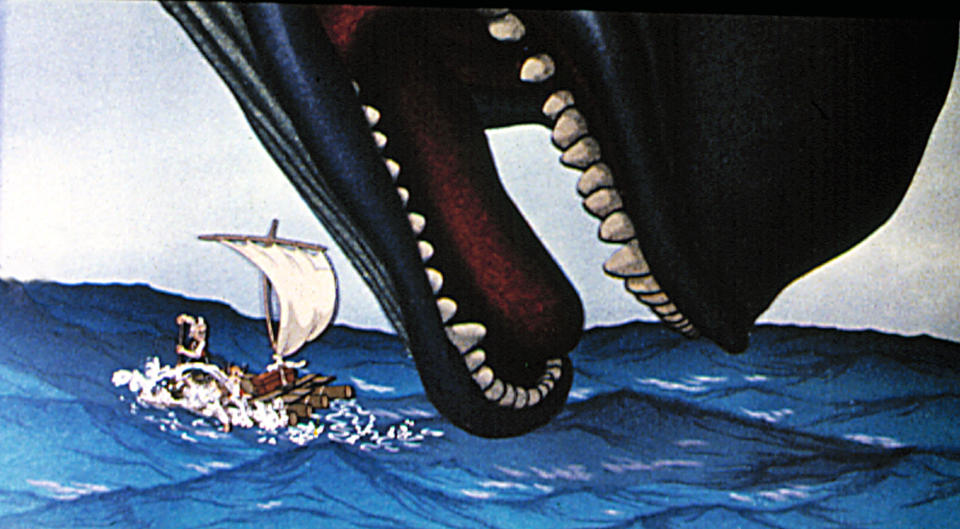
Although Pinocchio’s release preceded America’s entry into World War II by nearly two years, the conflict in the European theater had a big impact on the movie’s bottom line. “Pinocchio was released at a time when the world was kind of collapsing,” Disney explained in 1956. “As soon as the invasion of Europe came [in 1939], the market collapsed and our English pounds were frozen.” Produced for around $2.3 million, the film earned well under that. The commercial failure of Disney’s third animated feature, Fantasia, in November further jeopardized the studio’s future.
Funnily enough, the very conflict that delivered a body blow to Pinocchio’s box-office grosses wound up throwing Disney a lifeline. Not long after Pearl Harbor spurred the U.S.A. into action, 500 American troops occupied his studio to protect surrounding aircraft factories. He then received a call from the U.S. Navy who made him an offer he couldn’t refuse. “The Navy department said, ‘Mr. Disney, we want you to make films on aircraft identification, and we want the first films in 90 days.’ I said, ‘What will they cost?’ And they said, ‘We have a budget of $80,000. Can you do it?’” Disney went on to produce multiple propaganda and technical productions for the government for the duration of the war, which helped his studio escape bankruptcy. As for Pinocchio, the film eventually found its audience during multiple theatrical re-releases and the rise of the home video era.
You can watch three deleted scenes on Disney+, but none of them features Mel Blanc’s missing voice
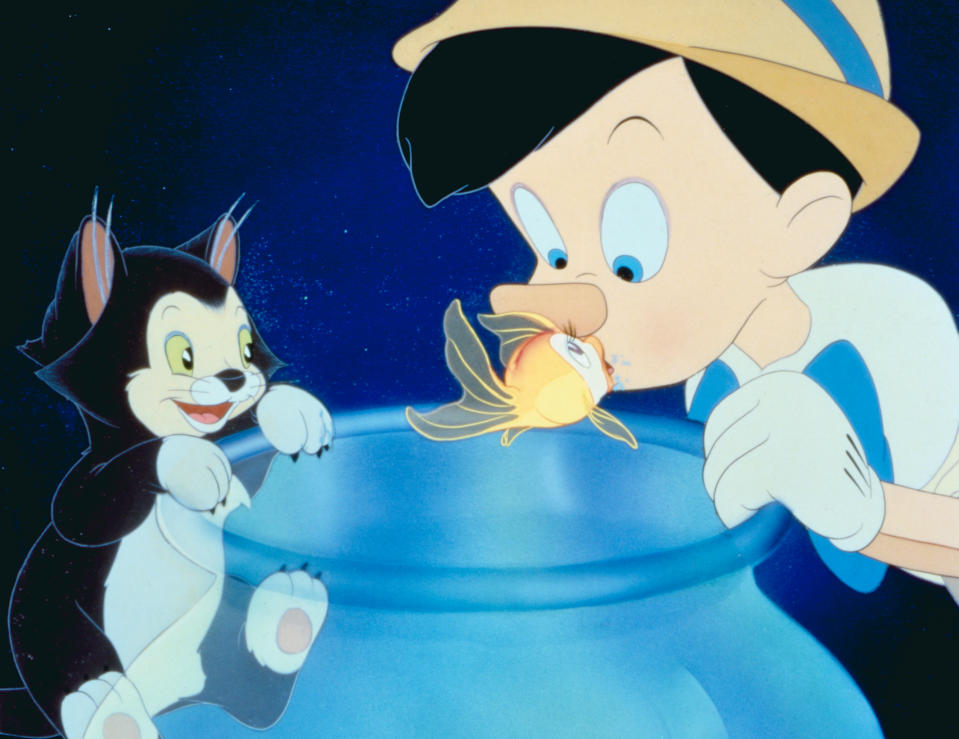
The very same year that Mel Blanc dropped his first “What’s up, doc?” in “A Wild Hare” — the animated short that made Bugs Bunny a household name — he almost joined the Disney pantheon as the voice of Gideon, the feline friend of fox con artist, Hungry John. During production, Disney decided to drop the cat’s dialogue entirely. Those burps you hear from Gideon, though? Those belong entirely to Blanc.
While the voiceover master’s full performance is lost to history, storyboards for three deleted scenes survive in the Disney vault and can be viewed among the supplementary material on Disney+. One such sequence was intended to come early on in the film, when Geppetto tells Pinocchio a bedtime story about the puppet’s majestic grandfather: an old pine tree. As conceived by the animators, this scene would have featured Geppetto’s face becoming the face of the tree, while the birds in his branches would resemble wooden marionettes. The action climaxes with a bolt of lightning splitting the tree’s bark — a problem it solves by tying two twigs around its midsection like apron strings.
The other deleted scenes come toward the end of the movie, including a longer sequence in the belly of the monstrous whale that swallows Geppetto, his pet fish, Cleo, and his pet cat, Figaro. Stuck without food, Geppetto starts to see sausages in piles of rope and fish dinners in fish skeletons. Figaro, meanwhile, eyes an actual fish dinner in Cleo, and makes repeated attempts to eat his owner’s other animal friend.
Last but not least is an alternate ending for the film, which takes place on a beach directly after Pinocchio saves the trio of prisoners from the whale’s belly. As the puppet approaches Geppetto’s prone body. “It’s all my fault! Look what I’ve done to him. I don’t deserve to have him back,” he cries. At that moment, a blue light appears and Geppetto wakes up to discover that Pinocchio has become a real boy, leading to an immediate celebration. That’s a departure from the theatrical version, where Pinocchio is the one who appears to have drowned and is resurrected by the Blue Fairy back at his creator’s shop. Both endings do feature the same final shot though: Jiminy Cricket gets his “Official Conscience” badge. Dreams do come true, indeed.
Pinocchio is currently streaming on Disney+.
Read more from Yahoo Entertainment:
Disney goes dark: The Mouse House's 8 scariest movie moments — and why they might be good for you
'The Little Mermaid' at 30: Why the Disney classic is actually a feminist film
Want daily pop culture news delivered to your inbox? Sign up here for Yahoo Entertainment & Lifestyle's newsletter.

